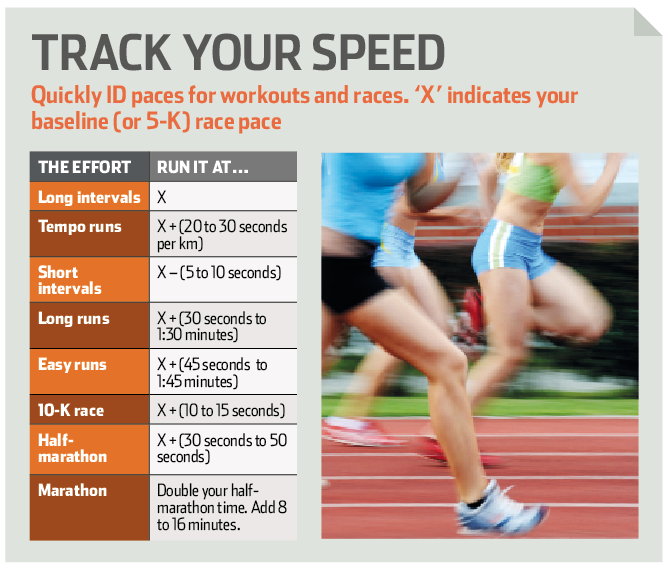How Fast (Or Slow) Should You Run?
Pace yourself. Sure, it sounds easy enough: settle into the perfect speed for your given effort and hold it. But whether you’re a seasoned veteran or an eager newbie, it can be hard to know if you’re going slow enough on easy days and fast enough on hard days.
Pace yourself. Sure, it sounds easy enough: settle into the perfect speed for your given effort and hold it. But whether you’re a seasoned veteran or an eager newbie, it can be hard to know if you’re going slow enough on easy days and fast enough on hard days. –

“You can’t go as hard as you want every time you work out, or you’ll have nothing left to race with,” says running coach and exercise physiologist Greg McMillan. “The goal is to train at various paces – usually at 50 to 70 per cent effort – so you can race at 100 per cent. This is difficult for most runners to follow.”
It’s hard in part because not every runner knows the speed from which to base those paces. Here’s how to nail the right pace for every workout.
Find your 5-K baseline
Many training plans base workout paces off your 5-K race pace. But if you’ve never run a 5-K or it’s been a while since you have, you’re probably under- or overestimating what that speed is, says coach Jonathan Cane.
Figure it out:Enter a 5-K and run at the hardest pace you can hold.
Don’t want to race? Run 3.5km at a steady, conversational pace, then pick it up for the final 1.5km to a speed at which you can speak only in phrases. “Whatever speed you can sustain in that last 1.5km is a good indicator of what your base pace should be,” says Cane. A few days later, run three 1600m repeats at that pace (jog 800m between each repeat).
If your third repeat is at least as fast as the first one, your baseline pace is ideal. But if each 1600m is progressively slower or you have to walk the recovery interval, adjust your base 5-K pace by taking the average speed of the three intervals.
“It’s hard to give a race effort during a training run, so doing your own time trial won’t be very accurate,” says Cane. “This two-pronged approach will help you gauge your speed better.”
Assign workout times
Once you’ve established your baseline 5-K pace, use it to determine how fast to run your workouts.
“Your goal is to create the least possible stress on your body that produces the maximum physiological benefits – not maximum stress to accomplish the same benefits,” says Dr Jack Daniels, head coach with The Run S.M.A.R.T. Project in the US. In other words, don’t run one second faster than necessary.
Figure it out: Run long intervals, such as 800m repeats, at base 5-K pace, and short intervals, such as 200- to 400m repeats, at about 5 to 10sec/km faster than that, says Cane.
Do tempo runs at 20 to 30sec/km slower than 5-K base, easy runs 45sec to 1:45min slower, and long runs 30sec to 1:30min slower. New runners should add more time; regular racers can aim for faster times.
Adjust with care
“Runners always want to finish a little faster,” says Vince Sherry, a running coach and co-founder of The Run S.M.A.R.T. Project. “We reach a race goal, and then all of a sudden it’s not good enough.” It’s easy to think that if you can run a workout – or even a portion of one – slightly faster, then you’ve stepped things up. But a good day (or moment) doesn’t necessarily translate into a new benchmark. For example: you’re supposed to run six 1600m repeats at 7:30 pace. Instead, you nail the first two repeats in 7:15.
The resulting fatigue causes you to run the last four in 7:40. Result? The too-fast start makes for a slower workout. “It’s not until you’re consistently clocking quicker repeats that you’re ready to boost your training speed,” says Sherry.
Figure it out: When it’s time to pick up your base 5-K pace, do it in segments, says Sherry. Instead of trying to run 1600 metres 10 seconds faster than usual, break it up into 400-metre repeats, with a 400-metre recovery jog or walk between each. Aim to shave two to three seconds off each lap.
This allows you to dial in the pace before applying the adjustment to longer segments. Pay attention to trends in your training as well. “If you’re a few seconds slower than predicted one day, that’s fine,” says Cane. “If you’re slowing down every Tuesday, you might be pushing too hard on Monday and need extra recovery time.” But if you’re constantly coming up short on key workouts no matter when you perform them, it’s time to go back and re-adjust your baseline pace. ’


